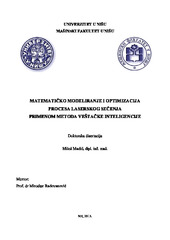Приказ основних података о дисертацији
Matematičko modeliranje i optimizacija procesa laserskog sečenja primenom metoda veštačke inteligencije
Mathematical modeling and optimization of laser cutting process using artificial intelligence methods
| dc.contributor.advisor | Radovanović, Miroslav | |
| dc.contributor.other | Marinković, Velibor | |
| dc.contributor.other | Manić, Miodrag | |
| dc.contributor.other | Nedić, Bogdan | |
| dc.creator | Madić, Miloš | |
| dc.date.accessioned | 2016-01-05T13:22:05Z | |
| dc.date.available | 2016-01-05T13:22:05Z | |
| dc.date.available | 2020-07-03T16:04:26Z | |
| dc.date.issued | 2013 | |
| dc.identifier.uri | https://nardus.mpn.gov.rs/handle/123456789/3892 | |
| dc.identifier.uri | http://eteze.ni.ac.rs/application/showtheses?thesesId=937 | |
| dc.identifier.uri | https://fedorani.ni.ac.rs/fedora/get/o:800/bdef:Content/download | |
| dc.identifier.uri | http://vbs.rs/scripts/cobiss?command=DISPLAY&base=70052&RID=533541782 | |
| dc.description.abstract | Laser cutting is one of more attractive non-conventional machining technologies which is being increasingly used in industry due to its efficiency. Laser cutting is based on the use of highly concentrated light energy, obtained by laser irradiation, for materials processing by melting or evaporation. Since it is desirable to remove the molten and evaporated material from the cutting zone as soon as possible, laser cutting is performed with a coaxial jet of an assist gas. From the technological point of view, laser cutting is a very complex process of interactions between the laser beam, assist gas and workpiece material, whose performances are influenced by a number of factors. Insufficient knowledge of the process as well as a lack of reliable and practical data about influential factors leads to underutilization of laser cutting technology with respect to the possibilities that it provides, but also to the fact that the cut quality does not satisfy users. In order to ensure achievement of the required cut quality, cost reduction and increase of productivity, it is necessary to quantify the relationships between process factors and process performances through the mathematical modeling. On the basis of developed relationships it is possible to perform a detailed analysis of the influence of process factors on process performances, identify near optimal factor values and control the process of laser cutting so as to improve the efficiency and cut quality. This paper presents the results of experimental studies carried out with the objective of modeling and optimization of laser cutting process i.e. assessment of process factors effects and application of obtained results for control of laser cutting process in order to increase the cut quality obtained in CO2 laser nitrogen cutting of stainless steel. Based on data from experimental studies carried out by using Taguchi’s orthogonal array, mathematical models relating cut quality characteristics and process factors such as laser power, cutting speed, assist gas pressure and focus position were developed. Mathematical modeling has been carried out using artificial neural networks, whereby the training of artificial neural networks was conducted by using Levenberg-Marquardt algorithm. On the basis of developed mathematical relationship between the cut quality characteristics and process factors, single and multi objective optimization of laser cutting was enabled. For the purpose of optimization two approaches were applied. The first approach is based on the integration of mathematical models created by artificial neural networks and meta-heuristic optimization methods. The second approach, which is aimed at determining the near optimal values of process factors in a way that the laser cutting process is robust to different causes of variation, was based on the application of Taguchi’s optimization method. In order to validate optimization solutions that were previously determined using different optimization methods, solve multi-criteria optimization problems and “off-line” control of laser cutting process, in the dissertation developed software prototype was presented. The modeling and optimization methodology presented in the dissertation and its implementation through the development of application software for industrial use, can raise planning of laser cutting process to a higher level and make process more economical and productive. | en |
| dc.format | application/pdf | |
| dc.language | sr | |
| dc.publisher | Универзитет у Нишу, Машински факултет | sr |
| dc.relation | info:eu-repo/grantAgreement/MESTD/Technological Development (TD or TR)/35034/RS// | |
| dc.rights | openAccess | en |
| dc.rights.uri | https://creativecommons.org/licenses/by-sa/4.0/ | |
| dc.source | Универзитет у Нишу | sr |
| dc.subject | Lasersko sečenje | sr |
| dc.subject | Taguči metod | sr |
| dc.subject | modeliranje | sr |
| dc.subject | optimizacija | sr |
| dc.title | Matematičko modeliranje i optimizacija procesa laserskog sečenja primenom metoda veštačke inteligencije | sr |
| dc.title | Mathematical modeling and optimization of laser cutting process using artificial intelligence methods | en |
| dc.type | doctoralThesis | en |
| dc.rights.license | BY-SA | |
| dcterms.abstract | Радовановић, Мирослав; Недић, Богдан; Манић, Миодраг; Маринковић, Велибор; Мадић, Милош; Математичко моделирање и оптимизација процеса ласерског сечења применом метода вештачке интелигенције; Математичко моделирање и оптимизација процеса ласерског сечења применом метода вештачке интелигенције; | |
| dc.identifier.fulltext | https://nardus.mpn.gov.rs/bitstream/id/52615/Disertacija.pdf | |
| dc.identifier.fulltext | http://nardus.mpn.gov.rs/bitstream/id/52615/Disertacija.pdf | |
| dc.identifier.rcub | https://hdl.handle.net/21.15107/rcub_nardus_3892 |


